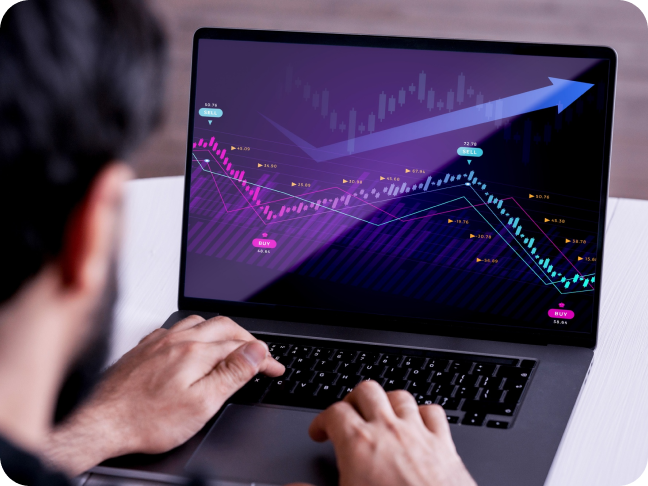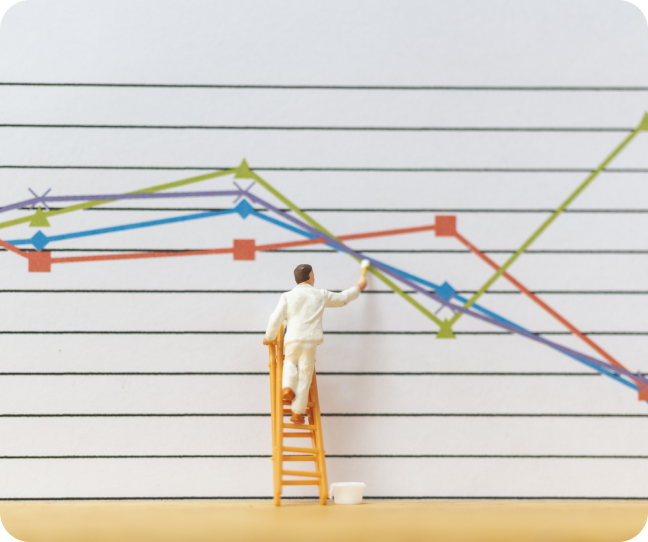


Prop traders often use algorithmic trading to take advantage of market inefficiencies with speed and precision
Instead of trying to operate across the global market’s 24-hour cycle, traders should concentrate on individual session windows
The best prop firms don’t impose minimum daily trade requirements, so traders can plan their trades according to their own preference
With the prop trading sector growing increasingly competitive, it’s essential to explore the breadth of trading strategies employed by top prop trading firms. These strategies are not only diverse but are tailored to harness the potential of various financial instruments, ultimately aiming to maximize profits and ensure sustainable growth. The best prop trading firms meticulously cultivate an environment where prop traders can thrive by using sophisticated trading platforms and leveraging extensive market data.
Trading strategies in the prop trading space cover a broad spectrum, from day trading to swing trading and global macro trading strategies. Each approach offers different benefits and risks, and the best strategy will depend on the trader’s specific financial goals, risk tolerance, and market conditions. Successful proprietary trading firms provide their traders with the education and tools necessary to navigate complex markets and to implement these strategies effectively.
The range of trading strategies available to those engaged with a proprietary trading firm is vast. In these firms, prop traders have the flexibility to operate with the same wide array of strategies they would manage if trading on their own capital. This includes everything from high-frequency trading to long-term thematic plays across various financial markets, including forex trading and futures trading.

Each trading strategy used by prop traders must be precisely calibrated. It requires a unique blend of timing, market insight, and a robust understanding of trading assets. The strategic use of technical analysis and trading software is critical in these settings, enabling traders to make informed decisions quickly. For instance, employing advanced algorithms can help identify trends in market liquidity and volatility, giving prop traders an edge over the competition.
Moreover, proprietary trading firms focus on fostering a culture where continuous learning and adaptation of trading strategies are encouraged. This is crucial in an industry where market conditions are constantly evolving. By keeping their trading strategies and approaches up-to-date, prop traders can adapt to new challenges and opportunities in the market, ensuring that they not only meet but exceed their profit targets while managing the risks associated with leveraging client funds.
The prop trading industry offers a dynamic environment where skilled traders can leverage diverse trading strategies to achieve substantial profits. As the industry evolves, the continuous refinement and adaptation of these strategies remain paramount for the sustained success of prop traders and the proprietary trading firms that support them.
Algorithmic trading has revolutionized the approach of prop trading firms to the financial markets, offering a method that leverages extensive historical trading data and sophisticated mathematical models. This technology enables prop traders to pinpoint and execute trading strategies with unprecedented speed and accuracy. By automating the decision-making process, algorithmic trading helps to capitalize on market inefficiencies and enhance the performance of prop trading.
Traders at top prop trading firms rely on algorithmic trading not just for its efficiency but also for its ability to minimize errors that human traders might make. This form of trading incorporates complex algorithms that analyze various financial instruments and market conditions in real-time, executing trades when specific criteria are met. The precision of algorithmic strategies is crucial in a fast-paced prop trading environment where milliseconds can mean the difference between profit and loss.
Over time, the strategies employed in algorithmic trading are meticulously refined and expanded to adapt to changing market dynamics. Proprietary trading firms invest heavily in trading software that can backtest strategies against historical data to ensure their effectiveness before live implementation. This rigorous testing is essential as it helps identify the most profitable and risk-averse strategies.
Moreover, algorithmic trading plays a pivotal role in reducing transaction costs for proprietary trading firms. It achieves this through enhanced trade execution, which reduces market slippage and improves profit margins. Advanced trading platforms used by these firms also allow for superior risk management, enabling traders to set precise parameters for trading activities, thus safeguarding against significant financial loss.

In addition to its core benefits, algorithmic trading supports prop traders by providing a framework for systematic trading that is devoid of emotional trading decisions. This scientific approach to trading ensures consistency in trading activities and can adapt to a diverse range of trading styles—from day trading to futures trading and everything in between. As a result, skilled traders and even beginner futures traders within these firms can achieve a higher degree of success and sustainability in their trading careers.
The integration of algorithmic trading within prop trading firms has not only optimized the execution of complex trading strategies but also contributed significantly to the broader field of proprietary trading. As financial markets evolve, the continuous innovation and adaptation of algorithmic trading will remain a cornerstone of success for many prop trading firms, driving forward their ability to meet and surpass financial targets.
Event-driven trading is a critical strategy employed by many prop trading firms and skilled traders, capitalizing on the market’s sensitivity to real-world occurrences. This method involves monitoring various financial markets, including forex, futures trading, and the stock market, to predict how significant events such as economic announcements, political developments, or corporate news will affect asset prices. Experienced traders and even beginner futures traders within proprietary trading firms use event-driven strategies to leverage information and anticipate market movements before they happen.
The cryptocurrency market is a prime example of a financial market that is highly responsive to news events. Each cryptocurrency token reacts distinctly to specific events, such as changes in regulatory landscapes, technological advancements, or shifts in consumer sentiment. Events like token unlock schedules, major business partnerships, and product launches can all trigger substantial price movements. Prop trading firms that engage in cryptocurrency markets must keep a keen eye on these events to execute timely trades.
Trading based on news events can be highly lucrative, especially for prop traders who possess a deep understanding of how events tie into broader market dynamics. This strategy requires not just an understanding of the markets but also an ability to perform technical analysis and use trading tools effectively to gauge the potential impact of news on financial instruments. News-driven trading offers a unique entry point for funded traders and aspiring traders who may still be developing a broader range of trading skills.

However, the challenge with event-driven trading in environments such as proprietary trading firms is the transient nature of news impact. For example, a positive earnings report from a leading investment bank may boost market sentiment temporarily, causing stock prices to surge. Yet, the effect might dissipate quickly as the market digests the news. Similarly, announcements related to financial institutions, mergers, or policy changes can cause sudden spikes in market liquidity that skilled traders must navigate carefully.
Moreover, the anticipation of news events is often built into the price of assets well before the actual events occur, making timing a critical component of successful event-driven trading. Prop traders must not only anticipate the news but also understand its potential long-term impact on financial markets and trading assets. This involves a sophisticated strategy where both the firm’s and the trader’s objectives align to exploit these short-lived opportunities effectively.
Event-driven trading requires a blend of quick reflexes, thorough market knowledge, and an adept use of trading software and platforms. Prop trading firms that excel in this area provide their traders with the tools and information necessary to benefit from the volatility and opportunities presented by major news events. By continuously refining their strategies and staying ahead of news cycles, these firms and their traders can achieve significant gains, proving once again that in the competitive world of prop trading, information is as valuable as capital.
Pair trading, a staple in the repertoire of skilled traders at many prop trading firms, involves taking a long position on one financial instrument and a short position on another. This sophisticated trading strategy is designed to capitalize on the relative price movements between the two assets. By strategically selecting pairs of stocks, forex pairs, or other financial instruments that exhibit historical or predicted correlation, prop traders can hedge against market volatility and reduce risk.
In proprietary trading, pair trading is highly regarded for its effectiveness in managing risk. It mitigates the potential losses from one asset with the gains from another, particularly useful in volatile financial markets where directional movements can be unpredictable. This method is crucial for both experienced traders and funded traders who seek to maintain steady gains while minimizing potential downturns.
The success of a pair trading strategy at a prop firm hinges on the sustained correlation between the chosen pairs. Prop trading firms often use advanced trading software and technical analysis to identify and monitor these correlations, ensuring that the pairs selected for trading maintain a predictable relationship over time. This analysis is critical because the moment the correlation deviates significantly, the strategy may need to be reevaluated to avoid losses.
Furthermore, the effectiveness of pair trading within a proprietary trading firm is not solely reliant on historical data but also on a real-time assessment of market conditions. Trading platforms play a crucial role here, providing prop traders with up-to-date information that can signal when a correlation is beginning to weaken. This proactive approach in the prop trading space helps traders adjust their positions or exit trades before the strategy becomes ineffective.

Pair trading also offers a unique opportunity for prop firms to diversify their trading strategies by incorporating different asset classes. For example, a common approach might involve pair trading between a stock and a related futures contract, or between commodities and related currency pairs in forex trading. This not only broadens the range of trading opportunities but also enhances the firm’s ability to leverage various financial instruments for maximum profitability.
Pair trading is a dynamic and strategic approach used by top prop trading firms to exploit market inefficiencies through careful correlation analysis and risk management. By maintaining a balanced exposure to complementary assets, prop traders can secure consistent returns while safeguarding against market fluctuations. As financial markets evolve, the continuous adaptation and technical refinement of pair trading strategies remain crucial for achieving long-term success in proprietary trading.
The Relative Strength Index (RSI) is a pivotal momentum indicator in the toolbox of technical analysis, employed extensively by traders at proprietary trading firms to measure the velocity and magnitude of directional price movements. This tool helps skilled traders identify potential entry and exit points by signaling whether assets might be undervalued or overvalued. It’s a crucial component for those focusing on trading assets across various financial markets, including stocks, forex, and futures trading.
Utilizing the RSI, traders at top prop trading firms develop strategies that detect divergence signals on higher time frames. This method is instrumental in predicting potential market reversals, a tactic that can significantly enhance the profitability of trading strategies. Additionally, the RSI’s ability to highlight overbought and oversold conditions helps traders make informed decisions about when to initiate or close positions, optimizing their profit targets and minimizing risks.
While the RSI is a powerful standalone tool, its effectiveness increases exponentially when combined with other technical analysis tools and financial instruments. Prop traders often pair the RSI with tools like moving averages, Bollinger Bands, or MACD (Moving Average Convergence Divergence) to validate the signals it provides and to construct a more robust trading strategy. This integrated approach allows for a more comprehensive analysis of market trends and asset prices, ensuring that traders are making well-informed decisions based on a diverse range of data.

At a prop trading firm, the RSI is also valuable for its application across different trading platforms and styles. Whether it’s day trading, swing trading, or global macro trading, the RSI provides insights that can be tailored to fit various trading strategies and time frames. Proprietary trading firms invest in advanced trading software that can automate RSI analysis, allowing prop traders to monitor multiple assets and markets efficiently, thereby enhancing their ability to react swiftly to market changes.
Furthermore, the RSI’s role in risk management cannot be overstated. By identifying potential price extremes, it aids prop firms in deploying capital strategically, ensuring that trades are both high in potential and controlled in risk. This is especially beneficial for funded traders and aspiring traders within these firms, who rely on the firm’s capital to make trades and need to adhere strictly to risk management protocols to protect client funds and maintain market liquidity.
The Relative Strength Index is more than just a metric for assessing market conditions; it is a fundamental component of the sophisticated trading arsenals at leading prop trading firms. By combining the RSI with a comprehensive suite of other analytical tools and strategies, these firms empower their traders to capitalize on market movements, maximize returns from their trading activities, and achieve sustained success in the competitive world of proprietary trading.
In the global financial markets, understanding the nuances of different trading sessions can greatly enhance a trader’s effectiveness. Traditional markets such as forex and stock trading are segmented into three primary sessions: Tokyo, London, and New York. Each of these sessions operates within specific time frames, creating unique opportunities and challenges for traders in proprietary trading firms and forex prop firms. By focusing on these individual session windows, traders can better manage their strategies according to the distinct characteristics of each market, including variations in market liquidity and activity levels.
Traders at top prop trading firms use detailed analysis of average returns from each session to develop a directional bias that informs their trading decisions. This approach allows them to capitalize on the inherent rhythms of financial markets, tailoring their strategies to exploit the best trading conditions available during these windows. The strategic concentration on session-specific trading enables skilled traders to optimize entry and exit points, thus maximizing the potential for profit while managing risk effectively.
Unlike the more traditional financial markets, the cryptocurrency market operates on a continuous 24-hour cycle, presenting a different set of challenges at a proprietary trading firm. However, even in this round-the-clock market, trading volumes show significant fluctuations that align with typical business hours across Asia, Europe, and the Americas. For crypto prop trading, recognizing these patterns is essential for making informed and profitable trading decisions.
Prop trading firms that specialize in cryptocurrencies must adapt their strategies to account for these fluctuations. By employing technical analysis and leveraging trading platforms equipped with advanced trading tools, these firms can monitor and respond to changes in trading volume and market sentiment during specific periods. This adaptability is crucial in maintaining an edge in the highly volatile crypto market, where geographic and temporal factors can still influence trading activities.

In both traditional and crypto markets, the ability to navigate through various global trading sessions effectively is a valuable skill for prop traders. By understanding the different market conditions that prevail during the Tokyo, London, and New York sessions, as well as the continuous nature of the cryptocurrency market, traders can refine their trading strategies. This includes making use of trading software to automate certain processes and using technical analysis to predict market movements more accurately.
Overall, session trading offers a framework for prop traders to structure their trading activities, ensuring that they are aligned with the most favorable market conditions. Whether dealing with stocks, forex, or cryptocurrencies, the strategic focus on session-specific characteristics helps proprietary trading firms enhance their market performance, manage client funds wisely, and achieve better outcomes for both the firm and its traders. This strategic approach not only capitalizes on the benefits of session trading but also mitigates the challenges posed by the global and continuous nature of modern financial markets.
Proprietary trading firms specializing in cryptocurrency offer a unique landscape where traders can access a wide array of strategies, similar to those available in more traditional financial markets. These firms empower prop traders to utilize advanced trading algorithms, which leverage artificial intelligence (AI) and machine learning to optimize trading decisions. Such cutting-edge technologies enable traders to harness the full potential of technical analysis tools like the Relative Strength Index (RSI) and other market indicators that pinpoint price discrepancies and trading opportunities across various financial instruments.

In cryptocurrency prop trading, traders have the flexibility to tailor their trading activities to suit their personal strategies and goals. They can segment their trading sessions to align with high-volume periods, which often coincide with specific time zones, thus capitalizing on the increased market liquidity. This methodical approach to trading allows for strategic planning and execution of trades, whether on short or long timeframes, without the constraints of minimum daily trade requirements—a hallmark of the best prop trading firms.
Proprietary trading firms that deal in cryptocurrencies provide their traders with the autonomy to plan and execute their trading strategies over varying timeframes, reflecting both the dynamic nature of the cryptocurrency markets and the diverse needs of their traders. This level of strategic flexibility is particularly beneficial for both seasoned and beginner futures traders within these firms, allowing them to leverage market movements effectively while managing risk according to their individual risk tolerance levels.
Moreover, the global nature of the cryptocurrency market means that prop traders can operate across a multitude of financial markets, each offering distinct challenges and opportunities. The lack of minimum trade requirements in top prop trading firms enhances this flexibility, enabling traders to engage with the market on their terms, focusing on maximizing returns and developing trading skills that are tuned to the fast-evolving landscape of digital currencies.

Prop trading in the cryptocurrency sector not only involves dealing with various financial instruments but also necessitates an acute awareness of global trading activities. This requires a robust platform that supports diverse trading strategies and advanced trading tools that facilitate effective market analysis and execution. The integration of AI and machine learning algorithms further refines these capabilities, providing traders with insights derived from comprehensive data analysis, thus enhancing decision-making processes and improving overall trade efficiency.
In conclusion, cryptocurrency prop trading within proprietary trading firms offers a compelling blend of flexibility, advanced technological integration, and strategic depth. These elements combine to provide prop traders with a powerful platform to maximize their trading potential while navigating the complex and often volatile digital asset markets. As the financial landscape continues to evolve, these firms stand at the forefront, continuously adapting and innovating to meet the demands of an increasingly sophisticated trading environment.